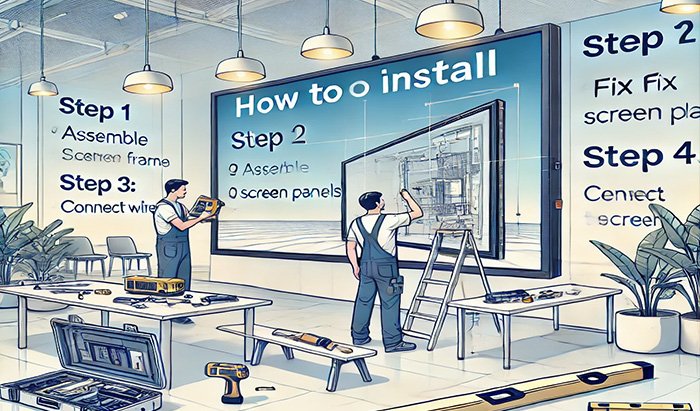In the constantly changing world of digital displays the SMD (Surface-Mounted device) screens are now a standard. From vivid advertising boards to stunning backdrops for events, SMD screens deliver exceptional images that attract audiences. However, installing them isn’t a straightforward, plug-and-play task. It’s an expertly orchestrated job that requires accuracy, planning and experience.
If you’re considering installing the SMD monitor, this complete guide will guide you through each step of the procedure. Let’s make your vision a realisation!
What is an SMD Screen?
SMD screens are a type of display. SMD Screen is a form of LED display in which the diodes are mounted directly on the board circuit. This technology permits amazing brightness, high resolution and vivid colors. These screens are employed for:
- Shopping malls
- Stadiums
- Outdoor advertising spaces
- Indoor conference rooms
- Concert stages
The attraction of SMD screens is in their smooth aesthetics and the flexibility they offer. No matter if you want a imposing outdoor billboard or an elegant indoor display SMD screens are capable of the job.
Benefits of Proper Installation
When installing an SMD screen correctly will guarantee:
- Langevity: Avoid unnecessary wear and tear.
- Maximum performance: Clear visuals and continuous operation.
- Protection: Prevent accidents caused by faulty wires or mounts that are unstable.
- cost efficiency: Cut down time and maintenance cost.
After we’ve learned the basics, we can begin the steps-by-step procedure.
1. Preparation: Setting the Foundation
Assess the Installation Site
First, analyze the site. Take into consideration the following factors:
- Indoor or outdoor? Outdoor screens require more protection from the elements and a higher level of brightness.
- viewing distance: As far as the public, the greater the screen and the pixel pitch needed.
- Structural integrity: The frame is able to be able to support the weight of the screen.
Choose the Right Screen
SMD screens are available in a variety of sizes as well as resolutions and styles. Take a look at these details:
- Pixel Pitch determines clarity and resolution.
- The brightness of the screen: In nits Higher brightness is required for outdoor screens.
- Refresh Rate Higher refresh rates will result in smoother and more fluid images.
Gather Tools and Equipment
Before you start, be sure you’ve got the following items:
- Mounting brackets
- Drills and screws
- Measuring tape
- Tools for electrical wiring
- Protective gear (gloves, goggles)
2. Safety First
Electrical Safety
- Switch off the power source before you begin working with wiring.
- Make sure your tools are insulated to avoid electrocution.
- Make sure you have a proper grounding system in place to prevent short circuits.
Structural Safety
- Verify the strength of the structure.
- Make sure you use high-quality anchors and brackets that are rated to your screen’s mass.
3. Planning the Installation
Design the Layout
The map will show the location for the screens. Things to think about:
- Perspectives of Viewing: Ensure the screen is clearly visible from all viewpoints.
- Content orientation: Determine if the display will show images in portrait or landscape.
Calculate Power Requirements
SMD screens use a lot of power. You should consult with an electrician on:
- Examine the total power.
- Install surge protectors in order to protect against the effects of power fluctuations.
- Make sure you have circuits that are dedicated for the screen.
Network Setup
If your monitor will show interactive content (e.g. videos and live feeds, etc.) make sure you have an effective network connection. There are several options to choose from:
- WiFi: Ideal for indoor configurations.
- Ethernet: Provides reliable connectivity.
- 4G/5G Modems: Ideal for remote outdoor screens.
4. Step-by-Step Installation Process
Step 1: Unboxing and Inspection
Remove carefully from the SMD screen and check every component for damage. Review the manual of the manufacturer to ensure that you have all the information you require.
Step 2: Prepare the Mounting Structure
- Wall-Mounted Screens Use sturdy brackets and ensure that they are at an even level.
- freestanding screens: Build the foundation and make sure it’s sturdy in the soil.
- Truss-Mounted screens: A common feature in events. Trusses have to be secured when rigged.
Step 3: Assemble the Screen Panels
Screens with SMD are usually made out of smaller screens. Take these actions:
- The panels should be aligned on the structure of mounting.
- Connect them with the supplied screws or clips.
- Verify that the alignment is seamless to ensure there are no obvious gaps.
Step 4: Wiring and Connectivity
- Attach power cable to panels.
- Connect data cables between panels according to the instructions of the manufacturer.
- Connect all cables in a clean manner to prevent tangling or interference.
Step 5: Test the System
After completing, power off the screen, and then check:
- All panels function.
- Color uniformity and brightness.
- Smooth transitions between panels. Smooth transitions between.
5. Calibration and Fine-Tuning
After assembly, adjust the screen to ensure the best performance:
- High-Brightness, Contrast and Lightness Make adjustments to the lighting conditions (e.g. darker indoors and brighter outside).
- color calibration: ensure uniformity on all panel.
- Alignment Make sure that all panels create an uniform display.
6. Troubleshooting Common Issues
Even with the best installation practices there are always issues that can occur. Here’s how you can address the issues:
Dead Pixels
- Replace the panel that is damaged.
- Contact the manufacturer to request replacements within the warranty period.
Connectivity Problems
- Verify the connections of data cables for security.
- Update drivers or firmware for Control system.
Color Inconsistencies
- Re-calibrate the screen with software tools.
- Adjust the individual panels as necessary.
7. Maintenance Tips
Regular maintenance will ensure that your SMD screen is performing well for years to come:
- Normal Cleaning Utilize a smooth dry, dry cloth to clean the screen. Avoid abrasive cleaners.
- Check Wiring: Regularly check for damaged or loose cables.
- Protect from Moisture For screens that are used outdoors be sure the seals for waterproof remain in place.
8. Best Practices for Longevity
- Regularly schedule inspections by experts.
- Update firmware and software to increase performance.
- Screens for outdoor use are protected with UV-resistant coatings.
FAQs
Q1. What is the cost to set up the SMD screen?
Costs can vary depending on the size, type and the level of complexity. Installation costs can vary from $1000 to $50,000.
Q2. Do I have the ability to install an SMD screen outdoors with no protection?
No, outdoor screens need weatherproofing in order to withstand elements such as dust, rain and extreme temperatures.
Q3. How long will the installation process be?
Installation time can vary from a few hours up to several days, based upon the dimensions and extent of your screen.
Q4. Do I need to put up an SMD screen by myself?
For screens that are small, DIY installation is possible using the appropriate tools and experience. However, professional assistance is suggested for larger screens.
Conclusion
The installation of an SMD screen can be a complex procedure, but with proper preparation and execution, you can design an impressive digital display that will meet your requirements. It doesn’t matter if it’s for events, advertising or for presentations, a properly-installed SMD screen will provide unbeatable quality and performance as well as visual appeal. Follow this step-bystep guide and you’ll get an impressive screen that will impress everyone who sees it.



0 Comments on “How to Install an SMD Screen: A Step-by-Step Guide”